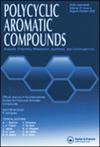新型吡啶并[1'',2'':2',3'][1,2,4]三唑并[5',1',2,3][1,3]噻唑并[4,5-b]吡啶的初探:合成、表征和抗菌效率
IF 2.4
3区 化学
Q2 CHEMISTRY, ORGANIC
引用次数: 0
摘要
3-aminothiazolotriazolopyridine-7,9-dicarbonitrile 3 通过 Vilsmeier-Haack 甲酰化反应得到了相应的醛衍生物 4,产率为 65%。底物 4 与一些伯胺反应,可以高效合成一些希夫碱 5-7。底物 4 与一些活性亚甲基腈反应生成了 2-氨基-3-取代的吡啶三唑并噻唑并吡啶 8-12。底物 4 通过与吡唑烷-3,5-二酮、5-氨基-2,4-二氢-3H-吡唑-3-酮和 5-苯基-2,4-二氢-3H-吡唑-3-酮的弗里德兰德反应,被用作多种吡啶三唑噻唑并吡唑 13-15 的关键中间体。此外,底物 4 与作为环烯胺的 5-氨基-3-甲基-1H-吡唑和 6-氨基尿嘧啶反应后,分别生成了吡啶三唑噻唑并吡唑吡啶 16 和吡啶三唑噻唑并吡唑嘧啶 17。对合成产物的抗菌效率进行了评估,其中一些产物显示出显著的活性。利用分析和光谱数据确认了合成产物的结构。本文章由计算机程序翻译,如有差异,请以英文原文为准。
First Approaches for the Novel Pyrido[1'',2'':2',3'][1,2,4]Triazolo [5',1',2,3][1,3]Thiazolo[4,5-b] Pyridines: Synthesis, Characterization and Antimicrobial Efficiency
Vilsmeier–Haack formylation of 3-aminothiazolotriazolopyridine-7,9-dicarbonitrile 3 afforded the corresponding aldehyde derivative 4 in a 65% yield. Some Schiff bases 5-7 were efficiently synthesized by reacting substrate 4 with some primary amines. Reaction of substrate 4 with some active methylene nitriles produced 2-amino-3-substituted-pyridotriazolothiazolopyridines 8–12. Substrate 4 was utilized as a key intermediate for a diversity of pyridotriazolothiazolopyrazolopyridines 13–15, through the Friedlander reaction with pyrazolidine-3,5-dione, 5-amino-2,4-dihydro-3H-pyrazol-3-one, and 5-phenyl-2,4-dihydro-3H-pyrazol-3-one. Further, the reaction of substrate 4 with 5-amino-3-methyl-1H-pyrazole and 6-aminouracil, as cyclic enamines, produced pyridotriazolothiazolopyrazolopyridine 16 and pyridotriazolothiazolopyridopyrimidine 17, respectively. The antimicrobial efficiency was assessed for the synthesized products, and some of them showed notable activity. The structures of the synthesized products were confirmed using analytical and spectroscopic data.
求助全文
通过发布文献求助,成功后即可免费获取论文全文。
去求助
来源期刊

Polycyclic Aromatic Compounds
化学-有机化学
CiteScore
3.70
自引率
20.80%
发文量
412
审稿时长
3 months
期刊介绍:
The purpose of Polycyclic Aromatic Compounds is to provide an international and interdisciplinary forum for all aspects of research related to polycyclic aromatic compounds (PAC). Topics range from fundamental research in chemistry (including synthetic and theoretical chemistry) and physics (including astrophysics), as well as thermodynamics, spectroscopy, analytical methods, and biology to applied studies in environmental science, biochemistry, toxicology, and industry. Polycyclic Aromatic Compounds has an outstanding Editorial Board and offers a rapid and efficient peer review process, as well as a flexible open access policy.
 求助内容:
求助内容: 应助结果提醒方式:
应助结果提醒方式:


